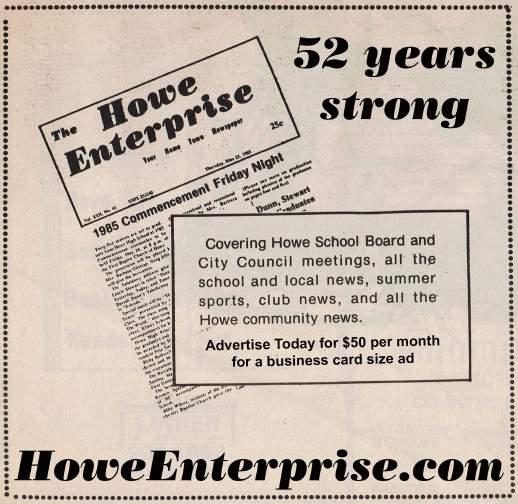
3 minute read
Learn about antiques and collectibles eorgia Caraway
postcard collecting had caught the public’s imagination in the United States and Tuck established an office in New York Postcards printed in the Tuck facilities in England and Germany were sent to the United States to be sold
I welcome questions about your antiques and collectibles and will try to answer them in my column Here is one I received from someone who came into Howe Mercantile I prefer answering questions this way rather than in the shop HAPPY NEW YEAR!!!
Advertisement
Q I own four Tuck postcards that appear to be of Civil War age The cards are in color with the edge border and the message background gilded. The figures are pressed in relief. There are no dates on the cards. They were printed in Saxony by royal appointment. Can you give me any information regarding their history and approximate value? The postcards are in exceptionally good condition E S
Smith, Howe
A Raphael Tuck started his business in a small shop in 1866 selling and framing pictures and chromolithographs printed by other companies primarily from Germany Raphael Tuck sold his wares in the streets of London from a wheelbarrow In 1871, his three sons had joined the firm and that Christmas Raphael Tuck and Sons published their first Christmas greeting That same year reduced postal rates added to the popularity of mailing greeting cards In 1880 the trademark of palette and easel was adopted, and the following year Raphael Tuck retired.
In 1894, Tuck’s son, Adolph, began experimenting with a picture postcard, and produced one photo postcard of Mt. Snowdon in Wales But it wasn’t until 1898 that an issue of 12 lithographed vignette views of London was produced These were followed by more London views and views along the Thames (36 in all) All were produced in Saxony from watercolor sketches By 1903,
Famous American artists such as cartoonist Clare Victor Dwiggins (signed “Dwig”), F Earl Christy (the University girls), Katherine Gassaway (wide-eyed children), Richard Outcault (father of “Buster Brown” and his dog Tige), Grace Drayton (innovator of the Campbell Kids), Frederick Opper (Happy Hooligan), and Frances Brundage (children) created Tuck designs for the American market. The vast surviving numbers of cards are in the U.S. and are comparatively scarce in England. The Tuck collectors’ sets include butterflies, Dickens’ characters, gallery art, the Presidents and Presidents’ homes, state belles and capitols, army and navy uniforms, Indians and Blacks Some consider the finest Tuck cards to be the lithographed private mailing cards and embossed heraldic views of several cities
Regrettably all records of the Tuck Company were destroyed when Raphael House was bombed in the blitz of London in 1940 Also destroyed were the original paintings from which the cards were reproduced, the lithographic stones, and all records of production
You have a part of one of the sets published for our Patriotic holidays The Decoration Day cards (Memorial Day) consist of the largest groupings. There are twelve cards to each set, embossed, and generally make use of flags as the motif. Yours is series #179 that has a gold wreath and star border and is striking in appearance. It heaps praise upon our country and it’s fallen heroes and is a lovely but difficult set to find One card reads, “It is little we can do to show our love for you, O warriors blest ” Another reads “Let the Stars and Stripes be waving, O’er their generous sacrifice,” another “Bring bright flowers the graves to garland, Let the sweetest music rise,” and “A grateful land remembers all her promises today.” Your cards have what is called in the postcard collecting field “divided backs.” Divided backs were introduced in England in 1902, however, they were introduced in the United States after 1907 Divided backs allowed room for the address on one side and a short message on the other side of the back Prior to this only the address was allowed on the reverse side, causing senders to write on the picture side The wording “Tuck’s Post Card, carte postale, postkarte, with the trademark artist’s easel and palette, Printed in Saxony, By Appointment, Art Publishers to their Majesties the King and Queen,” all indicate that these were printed for the American market
My estimate of value is $20-25 each, more if you had the complete set It might be fun to search for them on the Internet or at postcard shows. I suggest you put these cards in protective plastic sleeves made especially for storing postcards and tuck them away for future generations to enjoy.
Dr. Georgia Caraway, former director of the Denton County Museums for 14 years, and her friends opened the Howe Mercantile at 107 East Haning Store hours are Thursday through Saturday noon until 8 p m In addition to Tips, Tools, & Techniques: Caring for Your Antiques and Collectibles, she has written four Denton history books and is finishing a 5th history about the North Texas State Fair and Rodeo Reduced after-Christmas markdowns throughout the Howe Mercantile!
PLEASE SHOP LOCALLY We can show you Howe!






